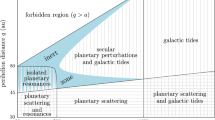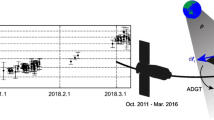Abstract
In this paper, we study the long-term dynamical evolution of highly elliptical orbits in the medium-Earth orbit region around the Earth. The real population consists primarily of Geosynchronous Transfer Orbits (GTOs), launched at specific inclinations, Molniya-type satellites and related debris. We performed a suite of long-term numerical integrations (up to 200 years) within a realistic dynamical model, aimed primarily at recording the dynamical lifetime of such orbits (defined as the time needed for atmospheric reentry) and understanding its dependence on initial conditions and other parameters, such as the area-to-mass ratio (A / m). Our results are presented in the form of 2-D lifetime maps, for different values of inclination, A / m, and drag coefficient. We find that the majority of small debris (\(>70\%\), depending on the inclination) can naturally reenter within 25–90 years, but these numbers are significantly less optimistic for large debris (e.g., upper stages), with the notable exception of those launched from high latitude (Baikonur). We estimate the reentry probability and mean dynamical lifetime for different classes of GTOs and we find that both quantities depend primarily and strongly on initial perigee altitude. Atmospheric drag and higher A / m values extend the reentry zones, especially at low inclinations. For high inclinations, this dependence is weakened, as the primary mechanisms leading to reentry are overlapping lunisolar resonances. This study forms part of the EC-funded (H2020) “ReDSHIFT” project.










Similar content being viewed by others
Notes
www.space-track.org. Assessed in 25 Oct. 2016.
See Tables 8–4 in Vallado (2013).
Note that the satellite’s initial node and perigee angles were taken relative to the ecliptic lunar values at each epoch.
Resonances are of the form \(\dot{\psi }=j\dot{\omega }\,{+}\,k\dot{\varOmega }\,{+}\,l\dot{\varOmega }_{M} = 0\). Lines crossing through the point \(\left( a,e\right) =\left( 0.518,0.5\right) \) correspond to \(\left[ j,k,l\right] =\left[ 0,1,-2\right] ,\left[ 2,1,-2\right] ,\left[ 2,-1,2\right] \). Lines passing through \(\left( a,e\right) =\left( 0.632,0.5\right) \) correspond to \(\left[ j,k,l\right] =\left[ 0,1,-1\right] ,\left[ 2,2,-2\right] ,\left[ 2,1,-1\right] ,\left[ 2,-1,1\right] ,\left[ 2,-2,2\right] \)
For \(i_{0}=5.2^\circ \) and \(i_{0} = 28.5^\circ \), we only take into account the population with \(q_{0}\le 800\) km, since, according to the dynamical maps presented in section 3.1, very few reentry solutions exist for higher altitudes.
One might be tempted to interpret these few particles as long-lived remnants of an initially larger population.
References
Angel Borja, J., Tun, D.: Deorbit process using solar radiation force. J. Spacecr. Rockets 43, 685–687 (2006)
Bottke Jr., W.F., Vokrouhlický, D., Broz̆, M., Nesvorný, D., Morbidelli, A.: Dynamical spreading of asteroid families by Yarkovsky effect. Science 294, 1693–1696 (2001)
Celletti, A., Galeş, C.: On the dynamics of space debris: 1:1 and 2:1 resonances. J. Nonlinear Sci. 24, 1231–1262 (2014)
Celletti, A., Galeş, C., Pucacco, G.: Bifurcation of lunisolar secular resonances for space debris orbits. SIAM J. Appl. Dyn. Syst. 15, 1352–1383 (2016)
Chao, C.-C.: Applied Orbit Perturbation and Maintenance. The Aerospace Press, El Segundo (2005)
Cook, G.E.: Luni-solar perturbations of the orbit of an Earth satellite. Geophys. J. 6, 271–291 (1962)
Cook, G.E., Scott, D.W.: Lifetimes of satellites in large-eccentricity orbits. Planet. Space Sci. 15, 1549–1556 (1967)
Daquin, J., Rosengren, A., Deleflie, F., Alessi, E.M., Valsecchi, G.B., Rossi, A.: The dynamical structure of the MEO region: long-term stability, chaos, and transport. Celest. Mech. Dyn. Astron. 124, 435–366 (2016)
Deienno, R., Sanchez, D.M., Prado, A.F.B.A., Smirnov, G.: Satellite de-orbiting via controlled solar radiation pressure. Celest. Mech. Dyn. Astron. 126, 433–459 (2016)
Ely, T.A., Howell, K.C.: Dynamics of artificial satellite orbits with tesseral resonances including the effects of lunisolar perturbations. Int. J. Dyn. Stab. Syst. 12, 243–269 (1997)
Gkolias, I., Daquin, J., Gachet, F., Rosengren, A.J.: From order to chaos in Earth satellite orbits. Astron. J. 152, 119 (2016)
Hughes, S.: Earth satellite orbits with resonant lunisolar perturbations. I. Resonances dependent only on inclination. Proc. R. Soc. Lond. A Math. Phys. Sci. 372, 243–264 (1980)
Hughes, S.: Earth satellite orbits with resonant lunisolar perturbations. II. Some resonances dependent on the semi-major axis, eccentricity and inclination. Proc. R. Soc. Lond. A Math. Phys. Sci. 375, 379–396 (1981)
Janin, G.: Decay of debris in geostationary transfer orbit. Adv. Space Res. 11, 161–166 (1991)
Janin, G., Roth, E.A.: Decay of a highly eccentric satellite. Celest. Mech. 14, 141–149 (1976)
King-Hele, D.G.: The orbital lifetimes of Molniya satellites. J. Brit. Interplan. Soc. 28, 783–796 (1975)
King-Hele, D.G.: Methods for predicting satellite orbital lifetimes. J. Brit. Interplan. Soc. 31, 181–196 (1978)
King-Hele, D.G.: Lifetime prediction for satellites in low-inclination transfer orbits. J. Brit. Interplan. Soc. 35, 339–344 (1982)
King-Hele, D.G., Walker, D.M.C.: Predicting the orbital lifetimes of Earth satellites. Acta Astronaut. 18, 123–131 (1988)
King-Hele, D.G., Walker, D.M.C., Pilkington, J.A.: The R.A.E. Table of Earth Satellites 1957–1986. Macmillan, London (1987)
Levison, H.F., Duncan, M.J.: The long-term dynamical behavior of short-period comets. Icarus 108, 18–36 (1994)
Lücking, C., Colombo, C., McInnes, C.R.: Solar radiation pressure-augmented deorbiting: passive end-of-life disposal from high-altitude orbits. J. Spacecr. Rockets 50, 1256–1267 (2013)
Morand, V., Le Fèvre, C., Lamy, A., Fraysse, H., Deleflie, F.: Dynamical properties of geostationary transfer orbits over long time scales: consequences for mission analysis and lifetime estimation. In: Proceedings of the AIAA/AAS Astrodynamics Specialist Conference, Minneapolis, Minnesota, Paper AIAA 2012-4968 (2012)
Morbidelli, A., Tsiganis, K., Batygin, K., Crida, A., Gomes, R.: Explaining why the uranian satellites have equatorial prograde orbits despite the large planetary obliquity. Icarus 219, 737–740 (2012)
Musci, R., Schildknecht, T., Flohrer, T., Beutler, G.: Evolution of the orbital elements for objects with high area-to-mass ratios in geostationary transfer orbits. Adv. Space Res. 41, 1071–1076 (2008)
Nesvorný, D., Alvarellos, J.L.A., Dones, L., Levison, H.F.: Orbital and collisional evolution of the irregular satellites. Astron. J. 126, 398–429 (2003)
Rosengren, A.J., Alessi, E.M., Rossi, A., Valsecchi, G.B.: Chaos in navigation satellite orbits caused by the perturbed motion of the Moon. Mon. Not. R. Astron. Soc. 464, 3522–3526 (2015)
Rosengren, A.J., Skoulidou, D.K., Tsiganis, K., Voyatzis, G.: Dynamical cartography of Earth satellite orbits. Adv. Space Res (2018). https://doi.org/10.1016/j.asr.2018.09.004
Rossi, A., and the ReDSHIFT team: The H2020 project ReDSHIFT: overview, first results and perspectives. In: Proceedings of the 7th European Conference on Space Debris (2017)
Rossi, A.: ReDSHIFT team: ReDSHIFT: a global approach to space debris mitigation. Aerospace 5, 64 (2018)
Sandifer, R.J., Shute, B.E.: Effect of solar–lunar perturbations on the lifetime of Explorer XII (abstract). Astron. J. 67, 282 (1962)
Scott, J.: Estimating the life of a satellite. Nature 180, 1467–1468 (1957)
Sharma, R.K., Bandyopadhyay, P., Adimurthy, V.: Consideration of lifetime limitation for spent stages in GTO. Adv. Space Res. 34, 1227–1232 (2004)
Shute, B.E., Chiville, J.: The luni-solar effect on the orbital lifetimes of artificial satellites with highly eccentric orbits. Planet. Space Sci. 14, 361–369 (1966)
Siebold, K.H., Reynolds, R.C.: Lifetime reduction of a geosynchronous transfer orbit with the help of lunar–solar perturbations. Adv. Space Res. 16, 155–161 (1995)
Skoulidou, D.K., Rosengren, A.J., Tsiganis, K., Voyatzis, G.: Long-term dynamics of artificial Earth satellites. In: Proceedings of the First Greek–Austrian Workshop on Extrasolar Planetary Systems, Ammouliani, Greece, September 2016 (2017)
Stefanelli, E., Metris, G.: Solar gravitational perturbations on the dynamics of MEO: increase of the eccentricity due to resonances. Adv. Space Res. 55, 1855–1867 (2015)
Upton, E., Bailie, A., Musen, P.: Lunar and solar perturbations on satellite orbits. Science 130, 1710–1711 (1959)
Vallado, D.A.: Fundamentals of Astrodynamics and Applications. Microcosm Press, Hawthorne (2002)
Wang, Y., Gurfil, P.: Dynamical modeling and lifetime analysis of geostationary transfer orbits. Acta Astronaut. 128, 262–276 (2016)
Wang, Y., Gurfil, P.: The role of solar apsidal resonance in the evolution of geostationary transfer orbits. Adv. Space Res. 59, 2101–2116 (2017)
Wisdom, J., Holman, M.: Symplectic maps for the N-body problem. Astron. J. 102, 1528–1538 (1991)
Acknowledgements
This research was funded by the European Commissions Horizon 2020, Framework Program for Research and Innovation (2014–2020), under Grant Agreement 687500 (Project ReDSHIFT; http://redshift-h2020.eu/). The work of DKS is funded by the General Secretariat for Research and Technology (GSRT) and the Hellenic Foundation for Research and Innovation (HFRI). Results presented in this work have been produced using the AUTH Compute Infrastructure and Resources and the authors would like to acknowledge the support provided by the Scientific Computing Office throughout the progress of this research work. DKS wishes to acknowledge Davide Amato for supplying a prototype routine for atmospheric drag and for providing independent validation of our code.
Author information
Authors and Affiliations
Corresponding author
Additional information
This article is part of the topical collection on Innovative methods for space threats: from their dynamics to interplanetary missions.
Guest Editors: Giovanni Federico Gronchi, Ugo Locatelli, Giuseppe Pucacco and Alessandra Celletti.
Rights and permissions
About this article
Cite this article
Skoulidou, D.K., Rosengren, A.J., Tsiganis, K. et al. Dynamical lifetime survey of geostationary transfer orbits. Celest Mech Dyn Astr 130, 77 (2018). https://doi.org/10.1007/s10569-018-9865-1
Received:
Revised:
Accepted:
Published:
DOI: https://doi.org/10.1007/s10569-018-9865-1




